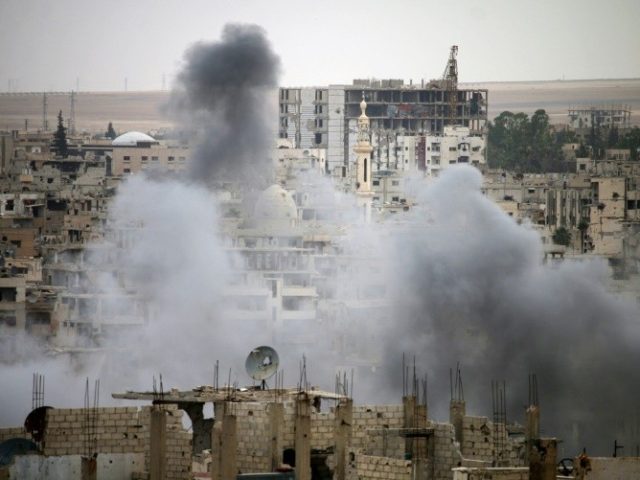This morning’s key headlines from GenerationalDynamics.com
- Thousands of Syrians flee into Jordan to escape bombing in Daraa
- Fears grow of Syrian army advance into Quneitra province
Thousands of Syrians flee into Jordan to escape bombing in Daraa

March 2017: Syrian troops advancing overnight in Hama (Al-Masdar)
The long-awaited assault by the regime of Syria’s president Bashar al-Assad on the southwestern province of Daraa appears to have begun on Thursday. According to Syrian state media, the Syrian army “carried out concentrated bombardments on dens and fortified positions of Jabhat al-Nusra terrorist organization and the affiliated groups in the northern and northeastern countryside of Daraa.”
Al-Assad considers all the people living in Daraa to be “terrorists,” even the women and children. Al-Assad has used an increasingly common way of committing ethnic cleansing and genocide. After brutal attacks on peaceful Sunni protesters in 2011, as soon as even one Sunni activist uses violence to get revenge, al-Assad has declared that millions of Sunnis are all “terrorists,” and he uses that as an excuse to conduct ethnic cleansing and genocide. In the past, al-Assad attacked women and children in Aleppo, Homs, and Ghouta with barrel bombs, chlorine, and Sarin gas, and now he is turning his attention to Daraa. According to reports, the Syrian army has assembled a large force, including tens of thousands of soldiers and more than 100 tanks.
Daraa province lies along the border with Jordan. Tens of thousands of people are fleeing the area, running south into Jordan to escape the bombing. Jordan is already hosting 650,000 refugees from the Syrian war, and is already in economic distress.
So far, the Syrian army has not started a ground offensive, but that could change at any time.
The U.S. State Department quickly denounced the Syrian action, accusing them of violating a previous agreement that Daraa province part of a “de-escalation zone” which is supposed to recognize a ceasefire:
The United States remains deeply troubled by reports of increasing Syrian regime operations in southwest Syria within the boundaries of the de-escalation zone negotiated between the United States, Jordan, and the Russian Federation last year and reaffirmed between Presidents Trump and Putin in Da Nang, Vietnam in November. Syrian regime military and militia units, according to our reports, have violated the southwest de-escalation zone and initiated airstrikes, artillery, and rocket attacks.
The United States continues to warn both the Russian government and the Assad regime of the serious repercussions of these violations and demands that Russia restrain pro-regime forces from further actions within the southwest de-escalation zone. During their call this weekend, Secretary Pompeo stressed to Russian Foreign Minister Sergey Lavrov the critical nature of mutual adherence to this arrangement and the unacceptable nature of any unilateral activity by the Assad regime or Russia. The United States expects all parties to respect the ceasefire, protect civilian populations, and avoid broadening of the conflict. We remain committed to maintaining the stability of the southwest de-escalation zone and to the ceasefire underpinning it.
The U.S. has threatened “serious repercussions” for violation of the de-escalation zone, without specifying what those repercussions might be. Syrian Arab News Agency (SANA, Damascus) and Arab News and US State Dept. and The National (UAE)
Fears grow of Syrian army advance into Quneitra province
Al-Assad has vowed to recapture all of southwest Syria from the “terrorists,” even though it is in a de-escalation zone. The actions taken so far in Daraa province, near the border with Jordan, have not evoked a strong response.
There is a great deal of concern, however, that the Syrian army will advance farther west from Daraa province in Quneitra province. Quneitra province borders the Israel-controlled Golan Heights, which is of much greater concern. From there, the Syrian army could attack targets in Israel, resulting in a larger war.
Israel has already made it clear that it will not tolerate Iranian or Hezbollah forces near the Golan border, and has previously targeted Iranian weapons systems and other Iranian targets approaching the border. Israel’s willingness to tolerate Syrian forces near the border is ambiguous.
The pressure on Israel to respond is further complicated by the fact that the situation along the border with Gaza appears to be deteriorating rapidly, with Hamas and Islamic Jihad sending dozens of rockets and burning kites across the border into Israel.
There are also suggestions in Israeli media that soldiers in Syria’s army are actually Hezbollah terrorists wearing Syrian uniforms. Whether this is paranoia or actually happening, there is clearly a perception that it’s happening, and that’s putting pressure on Israel to take military action in Daraa, Gaza or both. Al Masdar News (Damascus) and Israel National News and Debka (Israel)
Related Articles
- Russia-Israel alliance grows, while Russia-Iran alliance frays in Syria (19-Jun-2018)
- Israel makes deal with Russia as Syria’s al-Assad makes anti-US rant (02-Jun-2018)
- Israel bombs targets in Syria with Russia’s tacit cooperation (06-Dec-2015)
- Israel’s warplanes strike weapons depot inside Syria near Damascus (28-Apr-2017)
- Israeli kills protesters on Golan Heights (06-Jun-2011)
- Syria and allies threaten war with Israel in the Golan Heights (22-May-2013)
KEYS: Generational Dynamics, Syria, Bashar al-Assad, Daraa province, Homs, Ghouta, Aleppo, Jordan, Quneitra province, Israel, Golan Heights, Iran, Hezbollah, Gaza, Hamas, Islamic Jihad
Permanent web link to this article
Receive daily World View columns by e-mail

COMMENTS
Please let us know if you're having issues with commenting.